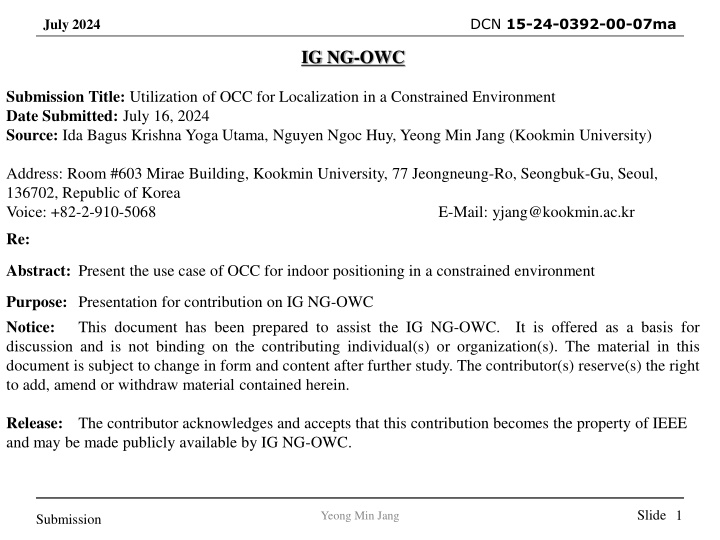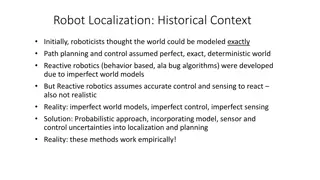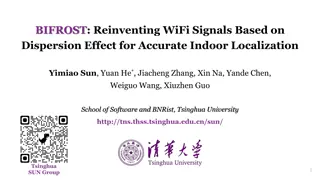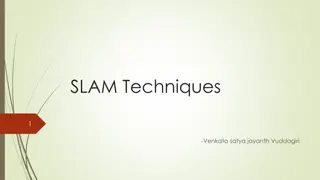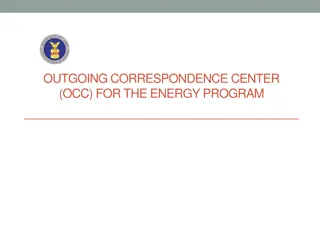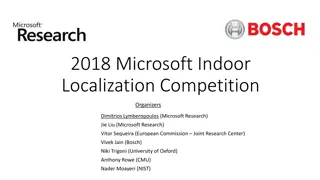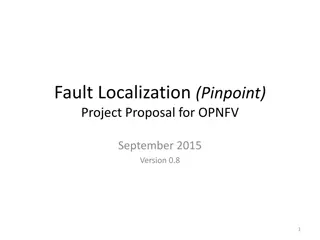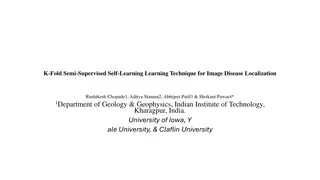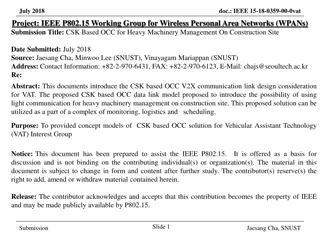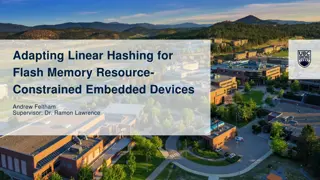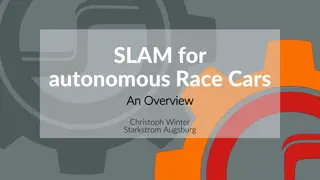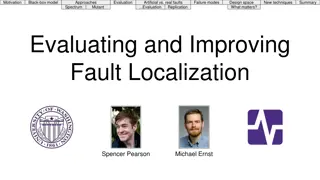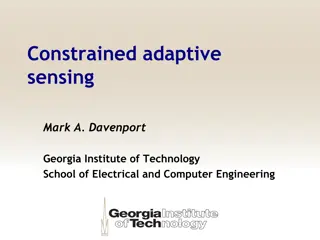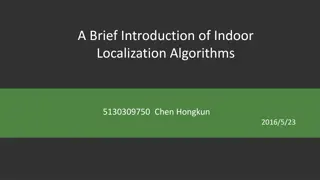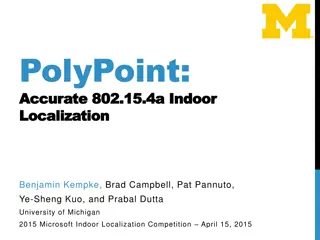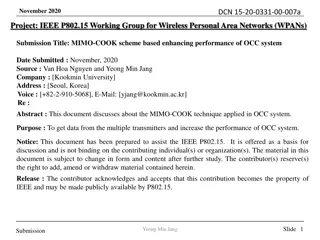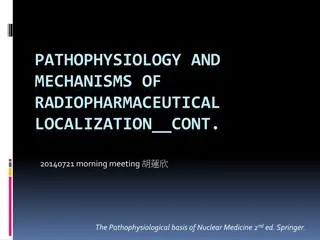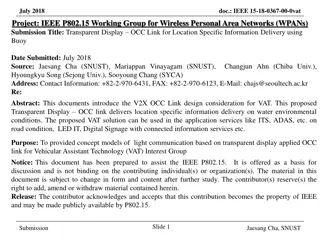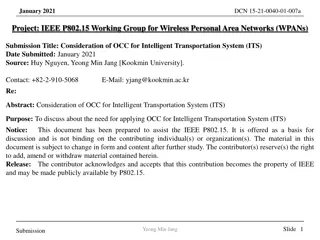Utilization of OCC for Localization in a Constrained Environment
Presenting the use case of OCC for indoor positioning in a constrained environment, focusing on the challenges and solutions for localization in scenarios like underground mines. Explore how technologies like INS, wireless sensor networks, and camera-based sensing play a role in addressing these constraints.
Download Presentation

Please find below an Image/Link to download the presentation.
The content on the website is provided AS IS for your information and personal use only. It may not be sold, licensed, or shared on other websites without obtaining consent from the author.If you encounter any issues during the download, it is possible that the publisher has removed the file from their server.
You are allowed to download the files provided on this website for personal or commercial use, subject to the condition that they are used lawfully. All files are the property of their respective owners.
The content on the website is provided AS IS for your information and personal use only. It may not be sold, licensed, or shared on other websites without obtaining consent from the author.
E N D
Presentation Transcript
DCN 15-24-0392-00-07ma July 2024 IG NG-OWC Submission Title: Utilization of OCC for Localization in a Constrained Environment Date Submitted: July 16, 2024 Source: Ida Bagus Krishna Yoga Utama, Nguyen Ngoc Huy, Yeong Min Jang (Kookmin University) Address: Room #603 Mirae Building, Kookmin University, 77 Jeongneung-Ro, Seongbuk-Gu, Seoul, 136702, Republic of Korea Voice: +82-2-910-5068 E-Mail: yjang@kookmin.ac.kr Re: Abstract: Present the use case of OCC for indoor positioning in a constrained environment Purpose: Presentation for contribution on IG NG-OWC Notice: This document has been prepared to assist the IG NG-OWC. It is offered as a basis for discussion and is not binding on the contributing individual(s) or organization(s). The material in this document is subject to change in form and content after further study. The contributor(s) reserve(s) the right to add, amend or withdraw material contained herein. Release: The contributor acknowledges and accepts that this contribution becomes the property of IEEE and may be made publicly available by IG NG-OWC. Slide 1 Yeong Min Jang Submission
DCN 15-24-0392-00-07ma July 2024 Utilization of OCC for Localization in a Constrained Environment Contribution July 16, 2024 Slide 2 Yeong Min Jang Submission
DCN 15-24-0392-00-07ma July 2024 Contents Introduction Existing Solutions Proposed Solutions Conclusion Slide 3 Yeong Min Jang Submission
DCN 15-24-0392-00-07ma July 2024 Introduction In a constrained environment, limited options are available to perform localization. In most cases, localization in a constrained environment requires a complex setup or heavy computation. One potential applications of localization in a constrained environment is underground mine. Nowadays, mine industry tries to apply a smart mining to improve the safety and health of the mine workers. Based on Xu, et al. [1], main issues for localization in underground mine are as follows: a. Lack of effective high-precision absolute positioning b. Long working time and high position accuracy requirements c. Complex working conditions, harsh underground environment, and the sensor contains large errors Slide 4 Yeong Min Jang Submission
DCN 15-24-0392-00-07ma July 2024 Existing Solution Currently, several methods emerges as solution to perform localization in a constrained environment: 1. Inertial navigation system 2. Wireless sensor networks 3. Camera-based sensing 4. LiDAR-based sensing Slide 5 Yeong Min Jang Submission
DCN 15-24-0392-00-07ma July 2024 Existing Solution 1. Inertial navigation system (INS) INS is an instrument that estimate the current position and attitude based on the accelerometers and gyroscopes data. Researchers has been utilizing the INS for localization in an underground mine [2]. Advantages Disadvantages Provide high-precision position and attitude information Accumulative error Provide a continuous position information The measurement should be performed continuously Less interference Easy to compute Slide 6 Yeong Min Jang Submission
DCN 15-24-0392-00-07ma July 2024 Existing Solution 2. Wireless sensor networks (WSN) Localization using WSN is performed by deploying a large number of sensor nodes across the environment. The equipment estimate its position by utilizing the position of the anchor nodes. The position can be recovered from the RSSI or CSI of the retrieved signal. Advantages Disadvantages Reliable and robust Complex sensor setup and deployment Provide instant position information, no accumulative errors Accuracy may decrease due to the environment structure, causing more NLOS signal Slide 7 Yeong Min Jang Submission
DCN 15-24-0392-00-07ma July 2024 Existing Solution 3. Camera-based sensing Camera-based sensing can be performed using two techniques, the visual odometry and visual landmark matching [3]. These methods utilize only image data to estimate the movement of the equipment and thus provide the position information. Advantages Disadvantages Low cost Accumulative error Simple to setup The camera lens may be obstructed by the dust or low-light environment Provide a continuous measurement Need a complex algorithm to generate a precise position and attitude estimation Requires a higher computation power Slide 8 Yeong Min Jang Submission
DCN 15-24-0392-00-07ma July 2024 Existing Solution 4. LiDAR-based sensing Localization using LiDAR-based sensing can be performed by using SLAM and odometry technique. The retrieved 3D point cloud data is processed to estimate the changes in position and attitude of the equipment while also allows for 3D map generation. Advantages Disadvantages Reliable Accumulative error Provide a continuous measurement Expensive to setup Need a complex algorithm to generate a precise position and attitude estimation Requires a high-power computation Slide 9 Yeong Min Jang Submission
DCN 15-24-0392-00-07ma July 2024 Proposed Solution The Optical Camera Communication (OCC) can be leveraged to establish the localization in a constrained environment. By integrating with OCC, the equipment only need to installed with a camera. Additional modification is also required on the underground mine by converting each lamp into an OCC transmitter. OCC TX < Underground mine > Source: https://www.ggled.net/wp-content/uploads/2020/07/iStock-1174789834-800x500.jpg Slide10 Yeong Min Jang Submission
DCN 15-24-0392-00-07ma July 2024 Proposed Solution Each OCC TX continuously broadcast its position which the broadcasted rays are received by the camera of the equipment. Then, the equipment compute its relative position to the OCC TX position to estimate its current position. To estimate the current position based on OCC, an angle-of-arrival (AOA) calculation should be performed [4]. The AOA measures the distance between the current position of the equipment with the center position of the OCC TX. Estimating position based on AOA and ceiling height information Slide 11 Yeong Min Jang Submission
DCN 15-24-0392-00-07ma July 2024 Proposed Solution By using OCC for localization in a constrained environment, a better localization system can be obtained. Advantages Disadvantages Reliable and robust Requires to modify the lamp into an OCC TX Provide an instant measurement No accumulative error Low cost Easy to setup No need for complex algorithm, only OCC RX and AOA calculation Low computation Immune to interference Slide12 Yeong Min Jang Submission
DCN 15-24-0392-00-07ma July 2024 Conclusion For constrained environment localization, several methods has been proposed. Among the existing methods, they have pros and cons that cause challenges when implementing it on the real environment. OCC emerges as a solution to perform the localization in a constrained environment. Unlike existing methods, OCC use less requirements and computations. The OCC also better when comparing the pros and cons with the existing methods. Slide13 Yeong Min Jang Submission
DCN 15-24-0392-00-07ma July 2024 Reference 1. X. Xu, L. Li, W. Jiao and Q. Zhang, "Challenges of Autonomous Navigation and Perception Technology for Unmanned Special Vehicles in Underground Mine," 2023 6th International Symposium on Autonomous Systems (ISAS), Nanjing, China, 2023, pp. 1- 6, doi: 10.1109/ISAS59543.2023.10164322. M. T. Dunn, J. P. Thompson, P. B. Reid and D. C. Reid, "High accuracy inertial navigation for underground mining machinery," 2012 IEEE International Conference on Automation Science and Engineering (CASE), Seoul, Korea (South), 2012, pp. 1179- 1183, doi: 10.1109/CoASE.2012.6386402. A. Jacobson, F. Zeng, D. Smith, N. Boswell, T. Peynot and M. Milford, "Semi- Supervised SLAM: Leveraging Low-Cost Sensors on Underground Autonomous Vehicles for Position Tracking," 2018 IEEE/RSJ International Conference on Intelligent Robots and Systems (IROS), Madrid, Spain, 2018, pp. 3970-3977, doi: 10.1109/IROS.2018.8593750. K. Bera, R. Parthiban, and N. Karmakar, A Truly 3D Visible Light Positioning System Using Low Resolution High Speed Camera, LIDAR, and IMU Sensors, IEEE Access, vol. 11, pp. 98578 98585, 2023, doi: 10.1109/access.2023.3312293. 2. 3. 4. Slide14 Yeong Min Jang Submission
